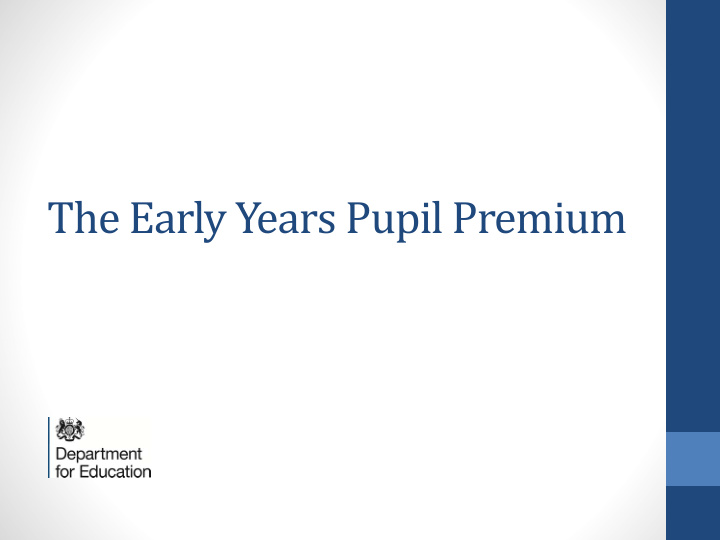



The Early Years Pupil Premium
Content • Introduction, key objectives and eligibility criteria – slides 3- 5 • Proposed funding arrangements – slide 6 • Checking eligibility and transitional arrangements – slides 7 • Effective use of the EYPP and evaluation – slides 9 and 10 • Group Discussion Topics 2
Introduction • On 18 March, the Deputy Prime Minister and the Prime Minister announced funding of £50 million in 2015-16 to support disadvantaged three and four year olds through an Early Year Pupil Premium (EYPP) • The EYPP will provide nurseries, schools and other providers of government funded early education with extra money for this group of children • It will be introduced in April 2015 • The Government consultation on the operation of the EYPP, which closed on 22 August attracted considerable interest – over 450 responses. We are currently considering these and will respond in due course 3
Key objectives We know that all children can benefit from a good early education. However: • Disadvantaged three and four year olds are up to 7 percentage points less likely to participate in early education; • In 2013 36% of pupils eligible for Free School Meal (FSM) achieved a good level of development in the early years foundation stage compared with 55% of other pupils; • 82% of early years settings are good or outstanding in the most affluent 20% of areas compared to 68% in the least affluent 20%. 4
Who will be eligible? The eligibility criteria mirrors the Schools Pupil Premium. Three and four year olds in any early years setting who: • Meet the criteria for FSM or • Have been looked after by the local authority for at least one day or • Have been adopted from care or • Are subject of a special guardianship and/or child arrangements order. 5
Proposed funding arrangements • £50 million in financial year 2015-16 • Allocated to LAs through the Dedicated Schools Grant (DSG) and from LAs to providers • Funding will follow the child (a set national per child amount) • Providers will be accountable for how funding is used 6
Checking eligibility We want LAs to be able to use the Eligibility Checking Service (ECS). • Providers will ask parents to identify if they are eligible and if so to provide their National Insurance Number (LAs won’t have to check all parents) • Providers will pass the NI number to LAs to check on ECS whether parents are in receipt of the relevant benefits to determine eligibility to EYPP • Parents will be given the option to opt out This may require changes to primary legislation. If so, we will aim to introduce them by April 2015. 7
How do we ensure that EYPP is used effectively? As with the Schools Pupil Premium, we propose the main accountability route will be through Ofsted: • Effective use and impact of the EYPP to be assessed under the leadership and management judgement • Amend the early years and schools census collections so that providers must identify which children in their setting attract EYPP 8
Supporting providers to make effective use of the funding • Evidence of good practice through organisations such as Education Endowment Fund • Peer support – re-focusing role of LAs in supporting Requires Improvement providers, and championing the interests of disadvantaged children • Growing the role of teaching schools in the early years, including supporting early years providers locally Understanding impact at national level • Outcome data • Data on quality and take up • Research on use of funding 9
PROTECT – NOT FOR WIDER CIRCULATION Discussion Topic 1 What type of advice/guidance from the DfE would you find helpful 10
Discussion Topic 2 How will you use the extra funding? • How might providers with a small number of eligible children use the funding to best effect? • How might providers with a large number of eligible children use the funding? 11
Recommend
More recommend